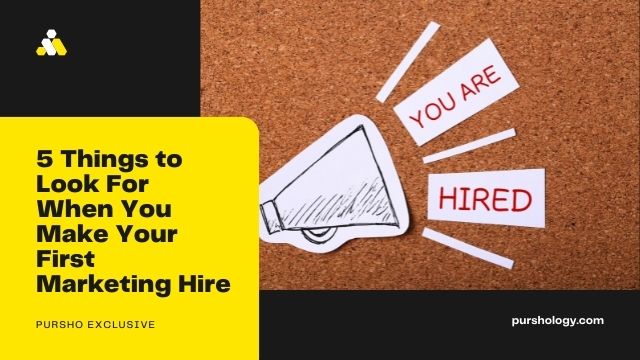Research reveals that wrong hiring affects approximately three in four employers. Moreover, a study by the U.S. Department of Labor suggests that the price of a bad hire is over 30% of workers’ first-year earnings.
Thus, it’s evident that making an appropriate marketing hire is critical to the productivity and success of your business.
In this article, we discuss the top things you must look for to optimize your first hire:
How Does Marketing Affects Business?
Marketing activities of a business refer to the buying and selling of a service/product. It involves selling, advertising, and delivering items to customers.
Since the primary function of a business is to attract customers, marketing is key to success. As such, marketing does not “impact” a company; instead, it’s something that contributes to its growth and prevents it from closing.
Here are several ways marketing affects the growth and expansion of a business:
Awareness
So, you’ve created a stellar company with innovative ideas. But does the world know?
Raising awareness is a critical function of marketing, which helps you connect with the thousands of potential customers who would love your products.
You can raise awareness about your product by publishing a blog showing off your expertise, issuing press releases, speaking at conferences, or running social media campaigns.
Remember, the goal is to get your company’s name out consistently and credibly.
Lead Generation
Among the top priorities for B2B marketers and sellers, lead generation is an excellent technique for ensuring growth.
To garner qualified leads, you’ll have to create buzz around your company. Thus, few prospects will buy your products or services if you have no brand awareness or credibility.
Increase Opportunities
Marketing your business, growing awareness, and boosting credibility can significantly impact your business.
For instance, new businesses can market and advertise on social media channels or by email to inform customers about their new product or service.
Challenges to Marketing in the Metaverse
In recent years, marketers have shifted to the metaverse to market and advertise their products. Research also reveals that the metaverse sphere will experience a CAGR of 47.6% from 2022 to 2029.
As the metaverse continues to revolutionize, so does the need to learn the challenges it poses. Let’s discuss three challenges companies face when marketing this revolutionary application:
Understanding the Means of Engagement
Marketing and advertising firms alike face the issue of finding a tangible means of engaging with buyers.
The fact is that marketing in the metaverse on platforms like Sandbox is different from the physical world. The biggest difference? The metaverse users want an authentic and reliable experience.
You can’t use billboards, commercials, or banner ads on the metaverse to attract buyers. Instead, you have to tap into your creative side to create highly-interactive, three-dimensional experiences.
Deciding which Metaverse to Market in
Here’s the truth: the metaverse is not one platform. Instead, it’s an expansive ecosystem of immersive and interactive virtual worlds, competing with others to host events, attract users, play-to-earn games, etc.
Today, several giants in the metaverse exist, such as Roblox, Sandbox, and Decenterland. Each platform attracts a different target audience and boasts unique features.
Thus, prospective advertisers must study these platforms to understand their respective demographics, land costs, monthly users, and growth opportunities before joining.
Gauging Performance
KPIs are critical to the success of a business. They include everything from financial measurements to customer-focused metrics, such as net profit, customer retention, sales, and customer satisfaction.
Unfortunately, marketing in the metaverse means you have to go beyond traditional KPIs and focus on one thing: engagement.
The better you engage and entertain your customers, the more success your business will enjoy.
Metrics You Should Look for to Optimize Your First Hire
An efficient hiring process with quality recruitment data and a qualified marketing team enables your business to make the ideal first hire.
For most businesses, the hiring process starts with monitoring recruitment metrics to identify solid areas and those that require work.
Here are five things you should look for when streamlining your hiring process:
Engagement
The engagement metric indicates the time a customer spends engaging with your website. Moreover, it helps you identify how engaging your page is to your target audience.
Customer Acquisition Cost
The customer acquisition process helps you identify how much it costs to acquire a customer throughout the buying journey.
To calculate CAC, you have to use this formula:
(Total cost of sales + Total cost of marketing) / Total new customers
Brand Equity
Brand equity plays a critical role in helping your brand stand out from the crowd.
Creating a distinct impression in your target customers’ minds helps you increase brand value and revenue.
Measuring social brand equity starts with identifying how effective and desirable your plan is and following it up with a robust tool that provides and logs insightful data.
Traffic Sources
Traffic source metrics measure which sources attract visitors to your website. Moreover, it lets you compare different areas.
Customer Lifetime Value
Another essential metric, customer lifetime value, indicates the financial value a business can expect from a customer.
The Bottom Line
The wrong hiring decision can cost your business thousands. More importantly, it can impact your business’ productivity, turnover rates, and employee morale.
Ensure you make the perfect first hire by overcoming the above-mentioned challenges and using the right metrics.




